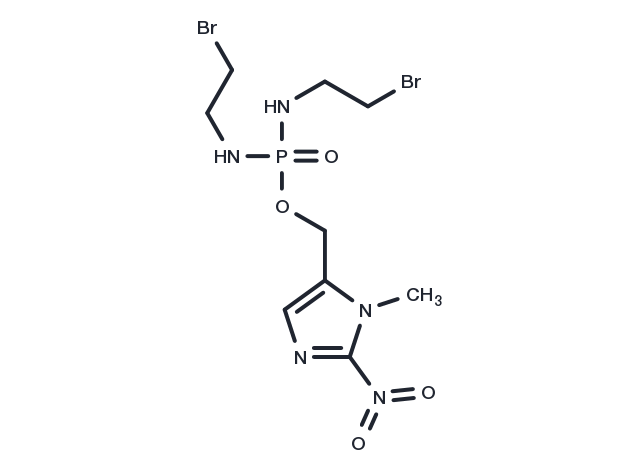Powder: -20°C for 3 years | In solvent: -80°C for 1 year
Evofosfamide (TH-302) is a hypoxia-activated prodrug of the cytotoxin bromo-isophosphoramide mustard (Br-IPM) conjugated with 2-nitroimidazole, with potential antineoplastic activity. When exposed to hypoxic conditions, such as those found in hypoxic tumors, the 2-nitroimidazole moiety of evofosfamide is reduced. This releases the DNA-alkylating Br-IPM moiety, which introduces intra- and inter-strand DNA crosslinks in nearby cells; the crosslinks inhibit both DNA replication and cell division and may lead to apoptosis of cells in the tumor. The inactive form of the prodrug is stable under normoxic conditions, which may limit systemic toxicity.

| 説明 | Evofosfamide (TH-302) is a hypoxia-activated prodrug of the cytotoxin bromo-isophosphoramide mustard (Br-IPM) conjugated with 2-nitroimidazole, with potential antineoplastic activity. When exposed to hypoxic conditions, such as those found in hypoxic tumors, the 2-nitroimidazole moiety of evofosfamide is reduced. This releases the DNA-alkylating Br-IPM moiety, which introduces intra- and inter-strand DNA crosslinks in nearby cells; the crosslinks inhibit both DNA replication and cell division and may lead to apoptosis of cells in the tumor. The inactive form of the prodrug is stable under normoxic conditions, which may limit systemic toxicity. |
| ターゲット&IC50 | Normoxia (21% O2):1000 μM, Hypoxia (N2):10 μM |
| In vitro | TH-302 is selectively potent under hypoxia and stable to liver microsomes. Substitution of the chlorine with bromine on the phosphorus mustard in 3b increases the potency by 10-fold and maintaines the high hypoxic selectivity [Hypoxia cytotoxicity ratio (HCR) = 270]. In both human lung cancer H460 cells and human colon cancer HT29 cells, potent cytotoxicity of TH-302 is observed under N2. TH-302 inhibits H460 cells and HT29 cells with IC90 of 0.1 μM and 0.2 μM, respectively. [1] TH-302 shows much enhanced potency in H460 spheroids compared to H460 monolayer cells under normoxia. [2] TH-302 exhibits potent cytotoxicity to MM cells with hypoxic selectivity and dose dependency. TH-302 can induce G0/G1 cell-cycle arrest under hypoxic conditions. The effect of TH-302 on cell-cycle machinery is mediated by down-regulating cyclin D1/2/3, CDK4/6, p21cip-1, p27kip-1, and pRb expression, whereas CDK2 expression remained undisturbed. TH-302 can induce dose-dependent apoptosis in both human and murine MM cells in hypoxic conditions. TH-302-activated apoptosis is mediated through down-regulating the antiapoptotic proteins BCL-2 and BCL-xL, as well as up-regulating the expression of cleaved proapoptotic protein caspase-3, -8, and -9 and poly ADP-ribose polymerase. In contrast to the hypoxia-specific toxicity, TH-302 shows very low toxicity in normoxic condition, even at high concentrations. [3] |
| In vivo | TH302 inhibits primary tumor growth by 41% on day 25 after implantation, whereas TH302 plus gemcitabine (a nucleoside analog) inhibits primary tumor growth by 96% on day 25. [1] When TH-302 is administered at 6.25, 12.5, 25, or 50 mg/kg in the H460 NSCLC xenograft model QD × 5/wk × 2 wks (once a day for 5 days per week for 2 weeks) i.p., the tumor growth inhibition at Day 22 is 43%, 51%, 75%, and 89%, respectively. TH-302 at 100 mg/kg shows a decrease in blood cell counts 3 days after treatment end, but is totally recovered 7 days post-treatment. TH-302 under all tested regimens exhibits efficacy metrics ranging from 58% to 89% tumor growth inhibition. TH-302 induced cell killing is breathing oxygen concentration dependent, with the greatest cytotoxicity occurring when the tumor-bearing mice are exposed to low oxygen concentrations. Tumor growth is significantly reduced by TH-302 in animals breathing 10% O2 compared with 95% O2 breathing. After TH-302 treatment, the pimonidazole-positive area is significantly decreased at 48 hours after dosing (6.3 % in vehicle vs. 1.8 % in the TH-302 treatment group). [4] |
| 細胞研究 | Exponentially growing human H460 or HT29 cells are seeded into 60 mm notched glass plates at 3 × 105 cells per plate and grown in RPMI medium supplemented with 10% fetal bovine serum for 2 days prior to initiating treatment. On the day of the test, TH-302 stocks of known concentrations are prepared in complete medium and 2 mL of the desired stock is added to each plate. The plates are placed in either an anaerobic chamber or a standard tissue-culture incubator. The anaerobic chamber is evacuated and gassed with the anaerobic gas mixture (90% N2/5% CO2/5% H2) to create a hypoxic environment. Cells are then incubated with TH-302 for 2 hours at 37 °C. At the end of treatment, plates are removed from each vessel and washed with phosphate-buffered saline and a solution of trypsin-EDTA and then trypsinized for 5 min at 37 °C. Detached cells are neutralized with medium plus serum and spun for 5 min at 100 g. Cells are resuspended at approximately 1 × 106 cells/mL and diluted 10-fold for plating. The exact concentration of each stock is determined. Known numbers of cells are plated and placed undisturbed in an incubator for between 9 and 13 days. Colonies are fixed and stained with a solution of 95% ethanol with 0.25% crystal violet stain. Colonies of greater than 50 cells are counted, and the surviving fraction is determined. Plating efficiencies (PEs) are determined by dividing the number of colonies by the actual number of cells plated. Surviving fractions are calculated by dividing the PEs of treated cells by the PEs of untreate(Only for Reference) |
| 別名 | TH-302 |
| 分子量 | 449.04 |
| 分子式 | C9H16Br2N5O4P |
| CAS No. | 918633-87-1 |
Powder: -20°C for 3 years | In solvent: -80°C for 1 year
Ethanol: 83 mg/mL (184.8 mM)
DMSO: 83 mg/mL (184.8 mM)
H2O: 10 mg/mL (22.27 mM)
You can also refer to dose conversion for different animals. 詳細
bottom
Please see Inhibitor Handling Instructions for more frequently ask questions. Topics include: how to prepare stock solutions, how to store products, and cautions on cell-based assays & animal experiments, etc.
Evofosfamide 918633-87-1 Apoptosis Others Inhibitor TH302 inhibit TH-302 TH 302 inhibitor
